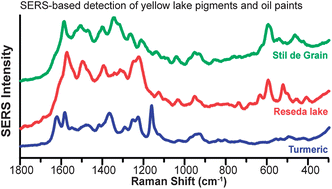Identifying natural, organic dyes and pigments is important for the conservation, preservation, and historical interpretation of works of art. Although previous SERS studies have demonstrated high sensitivity and selectivity for red lake pigments using various pretreatment conditions, corresponding investigations of yellow lake pigments and paints are relatively sparse. Here, surface-enhanced Raman scattering (SERS) spectroscopy is used to identify a variety of yellow organic dyestuffs and lake pigments in oil paint. High-quality SERS spectra of yellow dyestuffs (i.e., turmeric, old fustic, Buckthorn berries) and corresponding paints could be obtained with or without sample pretreatment using microliter quantities of HCl and methanol at room temperature. However, the SERS spectra of yellow lake pigments (i.e., Stil de Grain, Reseda lake) and their corresponding oil paints were only observed upon sample pretreatment. Ultimately, we demonstrate a reliable sample treatment protocol for SERS-based identification of turmeric, old fustic, Buckthorn berries, Stil de Grain, and Reseda lake as well as for microscopic samples of the corresponding oil paints.


 Please wait while we load your content...
Please wait while we load your content...